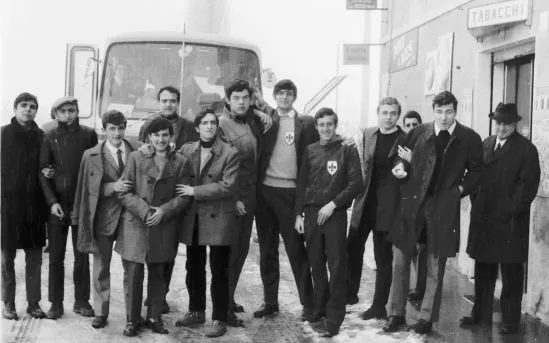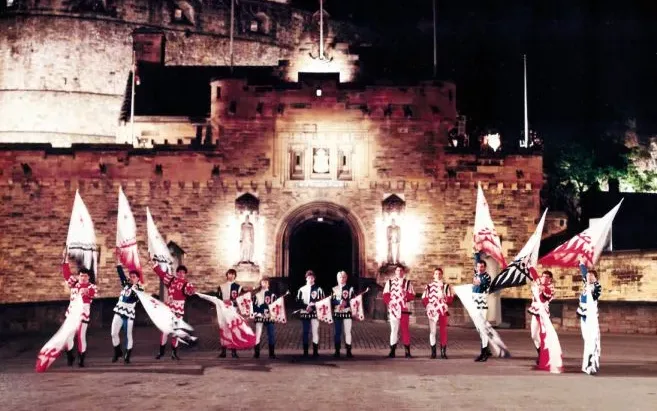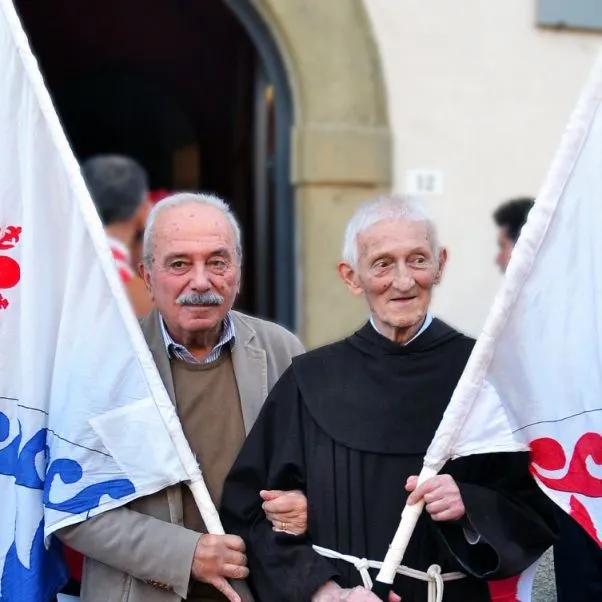History
The group was born in Figline Valdarno in 1965 thanks to the constant concern and the very careful work of Architect G. Mini together with Professor Father Zurlo, driven by the experience of Professor Dini and by all the teachers of the “Liceo Marsilio Ficino” . The trainings start for a few guys and the first three costumes are bought with the slender amount of money from the town of Figline and the Proloco administration of Incisa. The others are rent every time from the theatrical dressmaker in Florence. After careful studies the name of the group is chosen: “Borghi e Sestieri Fiorentini”. Figline , Incisa and Reggello were “Borghi” of Florence. Incisa and Figline in 1296 belonged to “Sesto of San Pietro a Scheraggio” and to “Sesto of Borgo”, which then became a district of Santa Croce. Our first standard consisted of a red lily on a white background with the inscription “Florentia” (Florence).
During the years the “Calcio Storico Fiorentino” (Florentine Historic Football), grew more and more interested in our Italian folk group so that in 1968 we were asked to join them as “Bandierai degli Uffizi”. However, in 1973 we split off in order to assert our independence and to be able to manage the group more effectively and easily. In the meantime, on the 22nd and 23rd of October 1966, in San Marino, together with other associations, the group gives birth to the “CONFEDERATION INTERNATIONALE DES ANCIENS JEUX ET DU SPORT DES DRAPEAUX (International Confederation of the Ancient Sports of Flags) e la FEDERAZIONE ITALIANA DEI GIUOCHI ANTICHI E SPORTS DELLA BANDIERA” (Italian Federation of the Ancient Games and Sports of Flags) and takes part to the games of Arezzo, Faenza, Bologna e Carovigno.

First photo of the group

Florentine Historic Football (1969)
Finally, in 1973, thanks to the former President Nannoni, the Italian folk group earns brand new costumes and a new statute. The amount of the members and that of national and international exhibitions is constantly growing. During the 80s, several important persons follow one another as chairmen (Honorable Pontello, Senator Spadolini, Doctor Bennelli).
The group’s standard is changed. Now it is a rampant golden lion - the symbol of Figline Valdarno - with half of a red lily on a white background and the inscription “Sbandieratori Borghi e Sestieri Fiorentini”. At the four sides of the flag, there are the crests of four important families in Valdarno (Castellani, Franzesi, Fabbrini, Serristori).

The group with Pelè during Football World Cup (1974)

Article of Newspaper "Gazzetta dello Sport" during Football World Cup (1974)

25th Anniversary of the Reign of Prince Rainieri of Monaco (1974)

Assisi (1980)

The Group with Pope Giovanni Paolo II (1987)

Royal Edinburgh Military Tattoo (1984)
Today the group is composed by 80 elements (subdivided into captains, drums, louds, lows, clarions and flag wavers) and by a school of flag which provides us new people and enables the group to keep loyal to those ancient traditions according to which this is an esteemed military art apart from of any round about, ostentatious tumbler game. In fact our aim is to tie up to the old tradition of the “Bandierai dei Liberi Comuni” (“Flags Wavers of the Independent Towns”), which has been peculiar of the free political system of our country since XI until the XV century. The Italian folk group is still very careful to observe this tradition of Italian folklore, both in style of movements and in the equipment. It is in fact one of the few to use wooden filled handmade flagstaff and rigorously embroidered fabrics.
For more on the history of the group, please refer to Prof. Aldo Pampaloni's Thesis : Link.

Live Chess Match of Marostica (2012)

Denver, Colorado, USA (2005)

Easter at Figline Valdarno (2012)

Orvieto (2014)
| FOUNDING MEMBERS | PRESIDENTS LIST | HONORARY PRESIDENTS |
|---|---|---|
| Baldo Baldi | 1966 - 1968 - Prof. Giovanni Brogioni | Prof. Dino Vittori |
| Bruno Burchi | 1968 - 1969 - Dott. Giovanni Ariano | On. Lelio Lagorio |
| Arch. Giuliano Mini | 1969 - 1970 - On. Edoardo Speranza | S.A.S. Ranier Grimaldi Principe di Monaco |
| Prof. Padre E. Zurlo | 1970 - 1976 - Rag. Garrone Nannoni | Sen. Giovanni Spadolini |
| 1976 - 1979 - Prof. Giuseppe Rausa | Mirella Costi Pignatelli | |
| 1979 - 1985 - Dott. Claudio Pontello | S.A.S. Albert Grimaldi Principe di Monaco | |
| 1985 - 1986 - Dott. Franco Sottani | ||
| 1986 - 1989 - Dott. Paolo Benelli | ||
| 1989 - 1996 - Prof. Alessandro Mini | ||
| 1996 - 2005 - Mirella Costi Pignatelli | ||
| 2005 - Dott. Stefano Torricelli |

Padre E. Zurlo and Giuliano Mini

Prince Rainieri III of Monaco

Mirella Costi Pignatelli

Dott. Stefano Torricelli